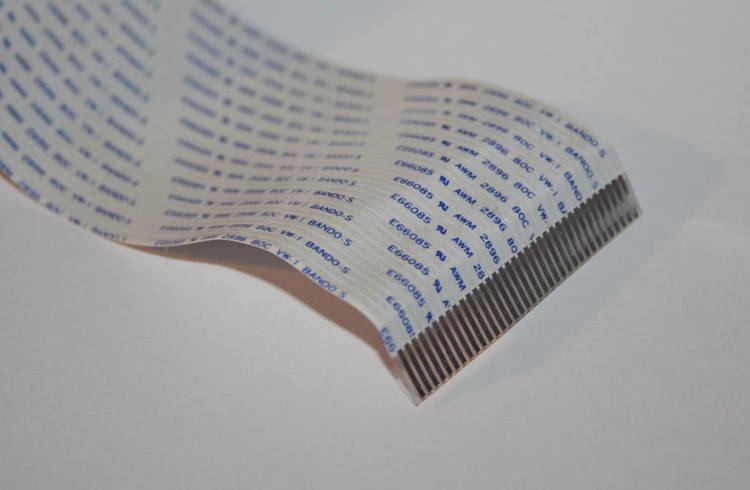 | ||
Flexible flat cable, or FFC, refers to any variety of electrical cable that is both flat and flexible. A flexible flat cable is a type of flexible electronics. However, the term FFC usually refers to the extremely thin flat cable often found in high density electronic applications like laptops and cell phones.
Contents
Overview
Sometimes the term FPC (flexible printed circuit) is even—somewhat inaccurately—used for any type of FFC, however this is more accurately used to describe circuits that incorporate components and are built onto a flexible material. FFCs are usually straight connections without any components.
FFC is a miniaturized form of ribbon cable, which is also flat and flexible. The cable usually consists of a flat and flexible plastic film base, with multiple metallic conductors bonded to one surface. Often, each end of the cable is reinforced with a stiffener to make insertion easier or to provide strain relief. The stiffener makes the end of the cable slightly thicker.
Flexible, flat cables are used in place of round cables for easy cable management, especially in high-flex applications. They usually take up less space than round cables, often offering better EMI/RFI suppression and eliminating wire coupling issues. In addition, because the wires are protected individually and not wrapped many times over by different materials as round cables are, they are lighter in weight and offer greater flexibility.
The ribbon cable was invented in 1956 by Cicoil Corporation, a company based in Chatsworth, California. The company's engineers figured out how to use a new material, silicone rubber, to 'mold' a flat cable containing multiple conductors of the same size. Since the cable looked like a flat ribbon or tape, it was named a ribbon cable. The ribbon cable allowed companies like IBM and Sperry/Univac to replace bulky, stiff round cables with sleek, flexible ribbon cables.
The early flat, ribbon cables were used in the mainframe computer industry, on card readers, card punching machines, and tape machines. Subsequently, ribbon cables were manufactured by a number of different companies, including 3M. Methods and materials were developed to simplify and reduce the cost of ribbon cables, by standardizing the design and spacing of the wires, and the thickness of the insulation, so that they could be easily terminated through the use of insulation displacement connectors (IDC). Due to the simplicity of ribbon cables, their low profile, and low cost due to standardization, ribbon cables are used today in most computers, printers, and many electronic devices.
Specifications
Now the FFC Cables are widely used in a variety of printer connection between the head and the motherboard, plotters, scanners, copiers, stereos, LCD appliances, fax machines, DVD players and other products, a variety of signal transmission and plate board connections. In modern electrical equipment, FFC Cables can be found almost everywhere.
